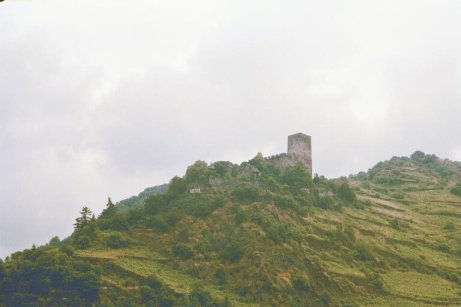 |
Rhine Revisited by Gregory E Bandlow
The town of Kaub was originally part of the city state of Mainz. In
1277, the town was sold to and its surrounding lands were sold to the
Palatinate. At the beginning of the 13th century the town gained
importance as it served as a collection point for custom duties on
the Rhine. Around the middle of the 13th century the Island fortress of
"Pfalzgrafenstein" was constructed. Shortly after its construction Pope
John XXII called on the archbishops of Mainz to destroy the tower as he
no doubt did not appreciate paying custom duties. The castle was besieged
for 6 1/2 weeks but managed to hold out. The valiant way the castle was
defended gave it the name "Gutenfels" The translation probably losses
something but to make an exact translation would be something like this.
"Guten" meaning good. "Fels" meaning rocky crag, unshakable, unwavering.

|
The castle in the middle of the river the "Pfalzgrafenstein" of Pflaz for
short had large chains suspended from its walls to each side of the river
bank, thereby making it impossible for ship traffic to pass with out
paying custom duties. The Pflaz is a five sided six story tower. It
is constructed in the shape of a ships hull. The outer wall shows a
stone lion bearing the coat of arms of the Palatinate. Behind this there
are gun bastions and a several storied wooden arcade with a sentry walk.
Because of the Rhine's flooding, the entry to the tower is on the third floor.
The dungeon is very interesting as the floor can be raised or lowered depending on
the Rhine's water level. The castle would not have been heavily defended but
relied on back up from the castles big brother, the Gutenfels artillery.
Kaub's previous fame came on New Years Eve 1813/14 when the Prussian
Field Marshall Blucher crossed the Rhine here in pursuit of Napoleon and
there is a museum in town at his former quarter to commemorate him and
his achievements.
Previous | Next
|
 |

